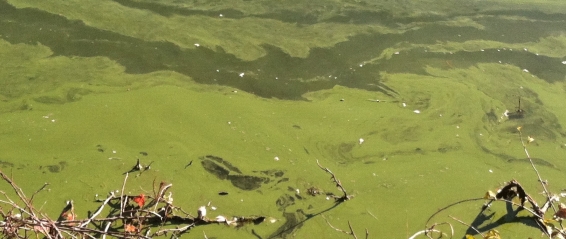Alum – Covers Up, But Can’t Correct
Alum – A Temporary, Toxic Nutrient Cap, Not a Sustainable Solution…
Alum treatment is often the “go to” strategy for moderate to severely impaired lakes caught in the grip of toxic algae growth. Here’s what’s wrong:
- Alum treatments do nothing to reduce nitrogen – the other nutrient critical to plant and algae growth.
- The phosphorus binds to the alum and stays in the ecosystem. ‘Locked’ phosphorus is re-released into the water column in as quickly as two years after the initial treatment.
- The Alum “cap” is consumed by carp and other “bottom feeders,” and disturbed/compromised by normal wind and wave action in shallow lakes.
- Alum is toxic to aquatic life and people. Repeated treatments can result in your lake-bottom being classified as “hazardous waste.”
- Alum is short lived, expensive, not sustainable – and certainly not good for the long-term health of the ecosystem.
A Thin, Fragile Coating Over of a Much Deeper Problem
Alum works by binding phosphorus in the water column and converting it into an aluminum phosphate compound, preventing phosphorous from being used by algae or weeds as food. As the alum settles to the bottom of the lake, it forms a micro-thin chemical “cap” that can absorb additional phosphorus as it is released from the sediments below.
But while there is no doubt that alum can bind to phosphorus and make it unavailable to algae and plants, there is considerable scientific doubt about how long an alum treatment can continue to deliver benefits to a treated lake. Many “experts” tout a 10 to 20 year benefit from a single, properly applied alum treatment.
In fact, the reality is that alum treatments most often deliver a benefit for fewer than 5 years with some lakes experiencing pre-treatment algae blooms in as little as 2 years after treatment. Beyond debates about how long alum treatments can last, there are more fundamental questions lake associations should consider before moving ahead with an alum program.
First, the cause of internal loading of phosphorus in lakes is its release by decaying lake-bottom muck and a lack of dissolved oxygen at the lake-bottom. The phosphorus that binds to the alum stays in the lake’s ecosystem. There are numerous scientific studies that indicate that this “locked” phosphorus can be re-released into the water column in as quickly as two years after the initial treatment. Second, alum treatments do nothing to reduce the other main nutrient critical to plant and algae growth – nitrogen.
Rather than mitigate the impact of phosphorus loading with alum, why not treat the root cause itself by restoring the oxygen balance to the lake? Lack of dissolved oxygen is the cause. Restore dissolved oxygen, aerobic bacteria and diatomic growth and phosphorous is naturally diverted to fish growth instead of weeds and toxic algae. That’s nature’s way.
Third, studies have shown that aluminum sulfate can be toxic to fish and other aquatic life. While buffered alum has been “deemed” safe, long-term impact studies have not been conducted. Is this a risk worth taking?
Short-term Results at a High Price
Finally, alum treatments cost an average of $3,000 to $4,000 per acre at recommended application rates. Given the track record of less than 5 years of benefit, over a 10 to 15 year period alum treatments are typically much more expensive than using laminar flow inversion and biological acceleration – which actually decreases in cost over time.
Alum is a potentially toxic mitigation strategy at best – not a true restoration strategy for improving the long-term health of your lake from the bottom up. To be quite blunt, alum treatment is like putting on a clean shirt when what you really need is a shower!
Lake Renewal: Sustainable Algae Control through Nutrient Reduction
Lake Savers Four Step Lake Renewal Process delivers sustainable nutrient and algae reductions at a fraction of the cost of an alum program.
























